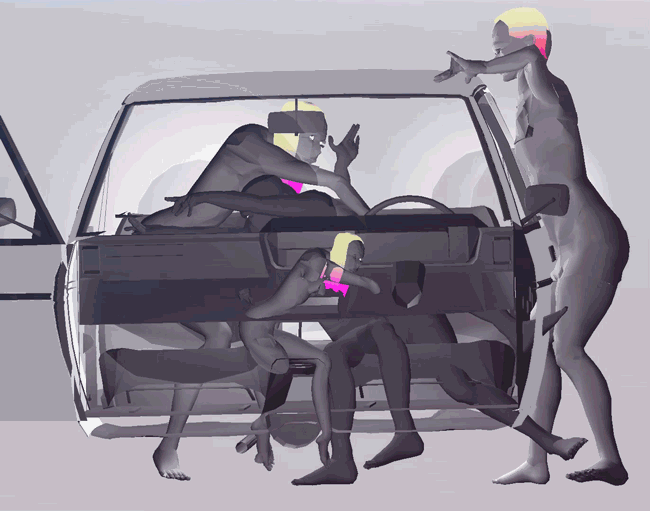
Ian Cheng, from This Papaya Tastes Perfect, 2011
I.
Here are the Germans in Arizona and New Mexico.
Their skin turning the coral-red of the veined rocks, of the local jewelry, as if the color had begun to rub off on them in the heat, some kind of desert frottage but really a sunburn is the just the opposite, if you think about it.
But that is how things are when they are opposites: you can't tell them apart.
Like the first time the group saw a Swastika on a native's cloth rug beady red inside a clutch of eagles, their wings eddying around it—one of them realized for the first time that the sign looked exactly like a miniature windmill (another learned later that in Navajo the symbol did almost mean that, in fact—"whirling log")
Another German was embarrassed; but for the others, this sign was a sign and they telegraphed Goebbels immediately.
It was like when Cortez had arrived in Mexico:
His men found that the natives there already worshipped a deity with long hair and fair skin, Quetzelcoatl, who had walked the earth before he ascended into the heavens. Ignoring any other possibility, Cortez understood this as the proof of the universality of Jesus, our Lord and Savior.
The Germans didn't know it then, but that turned out to be the "breakthrough" of their reconnaissance mission. It was the best these code crackers would do: discover a symbol they already all wore on their uniforms.
The rest of the Navajo language remained as much of a mystery as when it had first been captured coming across the Allied wireless.
After they returned home, those Germans still thought of the Allied Code, but something changed. It made no more sense, but before, whereas they had invariably pictured the Code as sparks, or static, percolating from iron spigots, now it looked different. Now it was something like a giant, vibrating quartz buried under the sand.
Sometimes, sitting in their listening posts, they'd find themselves talking to it, instead of listening—to the image of the rock under the sand. There wasn't anything to figure out anymore they just talked to it because they didn't know what else to do. They bitched and moaned to it, they sang folk songs to it, and when they woke up in the morning, and if they could remember, they told it parts of what they had just dreamt.
Their rational brain would never let their reptilian brain admit it out loud, but they liked it better this way—as a giant hidden rock. They liked it better than even the possibility of figuring out what it meant.

Ian Cheng, from This Papaya Tastes Perfect, 2011
IV.
The fashion was once to depict a thing inside itself. Here is the Stefaneschi Triptych (c. 1330) depicting nothing more than its master, Giotto, presenting a miniature of the same Triptych to his patron, Stefaneschi:
Giottos and Stefaneschis all the way down.
It is rarely mentioned, but during the brief moment when the Real Giotto presented The Real Triptych to The Real Stefaneschi, everyone in the church was struck with a prickling sensation at the base of their skull, as if someone was staring at them from behind but which they intuitively recognized instead as the feeling of bearing witness to one’s own birth.
We are told the proper term for this is Mise-en-Abyme, lit. put-in-the-center; Commonly misunderstood as Mis-en-Abime, lit. put-in-the-void which is commonly misunderstood as Mis-en-Abyme, lit. put-in-the-center which is commonly misunderstood as Mis-en-Abime, lit. put-in-the-void, etc.
That a thing has no content except for its form is often called Modernism, but the 20th century did not invent this, and even when Giotto painted it, he knew this meant he was already standing behind himself.
Take, for example, remembering that you just forgot something important. What is this a memory of? Or, remember a time when you begged yourself to make a lasting memory before a thing a slipped away. What is this of? a memory inside itself, a memory with “the sound of its own making”:
We imagine there is something truer than these loops but really these are the only memories we can trust for they are the ones that admit that a memory is at mercy to its own form.
Like this, each piece of fiction has its own non-fiction epilogue, an autobiography with the same plot.
Philip K. Dick wrote a story, “We Can Remember It For You Wholesale”. It is short and stilted, but with an ingenious premise about Doug Quail, a boring clerk who pays to be put under and pumped full of false memories so that he will wake up convinced he had lived a comic-book life as a secret-agent on Mars. The twist is that the doctor discovers his brain has no room for the false-memories because he really was a Martian secret-agent, and his boring clerk reality was the fake filler.
When the time came to make it into a movie, this was the elevator pitch (verbatim):
Ron Shusset (screenwriter): “We want to do Raiders of the Lost Ark Go To Mars.”
The executive starts seeing it in his head, right there in the fucking elevator:
Arnie, biceps akimbo…churning, churning.
And whenever he gets to see a working script, it’s all this artsy shit about what does it all mean, man? And he only ever has one comment: for chrissakes, get rid of all this talking, guns out to here, ok?
And so finally the script stops trying to be about Doug Quail and just starts trying to be like him. The idea is: why not just junk this whole boring thing (so much talking) and swap in images of a Laser-Guided Conan the Barbarian. Who needs to find some fussy memory-zapping doctor when you’ve got a whole goddamn soundstage full of Pyrotechnics.
cut the checks.
Now in Theaters: Total Recall, starring
Arnold Schwarzenegger
Get ready for the ride of your life.
During filming, Arnie became something like a mentor: he taught everyone that just winning isn’t enough, you have to go back and rub your boot in the guy’s face. So make Total Recall: the shoot-em up video game and above all, make Total Recall: The Book. In the end there was this glossy raised-cover slab with Arnie leering and it’s sitting right next to Philip K. Dick: The Collected Stories. And whither the thing? Sitting inside a representation of itself.
Editor's Note: This text is excerpted from the catalog text "I, II, III, IV, V" for Ian Cheng's This Papaya Tastes Perfect.

